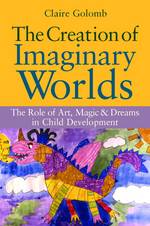 by Claire Golomb
by Claire Golomb
This enlightening book will be of interest to students of child development, art therapists, play therapists, counselors and child psychologists, as well as parents, teachers and anyone else who wishes to gain a better understanding of childhood imagination.
Full Description:
Alongside the world of everyday reality, the young child develops a rich imaginary world of child art, make-believe play, imaginary friends, fairy tales and magic. This book charts the imaginative development of children, conveying the importance of art-making, pretense play and fantasy in early childhood years, and highlighting the potential that imaginative behaviors hold for cognitive, affective and aesthetic development. Divided into three parts, the book begins by examining the development of child art and how children express themselves through art. Part two looks at make-believe play and suggests ways that these methods of play can be utilized effectively in play therapy. Finally, the author explores children's perceptions of fantasy and fiction as expressed in dreams, story-telling and magic. The Creation of Imaginary Worlds highlights the significance of imaginary worlds in children's lives, their role in fostering creativity and abstract thinking, and how adults can gain valuable insights into children's cognitive and emotional well-being. This enlightening book will be of interest to students of child development, art therapists, play therapists, counselors and child psychologists, as well as parents, teachers and anyone else who wishes to gain a better understanding of childhood imagination.
February 2011, 234mm x 156mm / 9.25in x 6in, 184pp
ISBN: 978-1-84905-852-0
List of Plates. List of Figures. Preface. 1. The Evolution of Child Art. Representational art and early models. Child art blossoms. The socio-cultural milieu. 2. Play: A Wellspring of the Imagination. Antecedents and the emergence of pretense behavior. Symbolic play. Make-belief play flourishes. The socio-cultural milieu. Play therapy. The school-age child and beyond. 3. Between Fantasy and Fiction. Dreams. Daydreaming or waking fantasy. Story telling. Fairytales. Magic. Concluding comments. 4. Epilogue. Notes. Further Reading. Index.
|